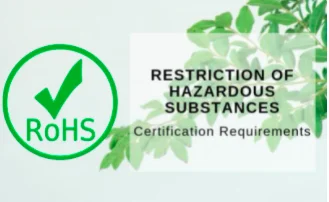Introduction
The Restriction of Hazardous Substances (RoHS) Directive, formally known as Directive 2011/65/EU, is a critical regulation in the European Union (EU) that restricts the use of specific hazardous materials in electrical and electronic equipment (EEE). Enacted to protect human health and the environment, RoHS certification ensures that products comply with limits on substances like lead, mercury, and cadmium, promoting safer manufacturing and disposal practices. As global demand for sustainable electronics grows, RoHS compliance has become a cornerstone for manufacturers seeking access to the European market and beyond. This article explores the significance of RoHS certification, the key substances restricted, the certification process, its benefits for businesses, and the challenges faced, providing a comprehensive guide for stakeholders in the electronics industry.
Significance of RoHS Certification
RoHS certification is a mandatory requirement for placing electrical and electronic products on the EU market, covering items from consumer gadgets like smartphones to industrial equipment. Its primary goal is to reduce the environmental and health risks posed by hazardous substances, which can contaminate soil, water, and air during product disposal or recycling. By restricting these substances, RoHS promotes safer recycling processes and minimizes occupational exposure for workers handling electronic waste.
The certification’s significance extends beyond regulatory compliance. It enhances a company’s reputation by demonstrating a commitment to environmental responsibility, a growing priority for consumers and regulators worldwide. RoHS compliance is also a prerequisite for market access in the EU, a region with over 450 million consumers, and is increasingly adopted in other markets like China and California, which have similar regulations. For manufacturers, RoHS certification fosters innovation, encouraging the development of safer, eco-friendly materials and processes, while aligning with global sustainability goals.
Key Substances Restricted by RoHS
The RoHS Directive restricts ten hazardous substances in EEE, with maximum concentration limits set at 0.1% by weight (except for cadmium, which is 0.01%) in homogeneous materials. The key restricted substances include:
-
Lead (Pb): Commonly used in solder and batteries, lead poses risks to neurological health and environmental contamination. RoHS limits its use, pushing manufacturers toward lead-free alternatives.
-
Mercury (Hg): Found in fluorescent lamps and switches, mercury is highly toxic, affecting the nervous system and ecosystems. RoHS restrictions promote safer lighting technologies like LEDs.
-
Cadmium (Cd): Used in pigments and batteries, cadmium is carcinogenic and environmentally persistent. Its lower limit reflects its high toxicity.
-
Hexavalent Chromium (CrVI), Polybrominated Biphenyls (PBBs), Polybrominated Diphenyl Ethers (PBDEs), and four phthalates (DEHP, BBP, DBP, DIBP): These substances, used in coatings, flame retardants, and plastics, are linked to health issues like cancer and reproductive harm. RoHS restrictions drive the adoption of safer alternatives.
Exemptions exist for specific applications where alternatives are not yet viable, such as certain medical devices, but these are time-limited and regularly reviewed. Compliance requires rigorous testing and documentation to ensure products meet these thresholds.
The RoHS Certification Process
Achieving certificazione rohs (ROHS certification) involves a series of steps to ensure compliance with the directive’s requirements. While RoHS is a self-declaration process in the EU, meaning manufacturers certify their own compliance, the process is rigorous and subject to market surveillance. The key steps include:
-
Identify Applicable Requirements: Determine if the product falls under the RoHS Directive’s scope, which covers most EEE categories, including household appliances, IT equipment, and lighting.
-
Conduct Material Analysis: Test components and materials to verify that restricted substances are within allowable limits. This may involve X-ray fluorescence (XRF) testing or chemical analysis by accredited laboratories.
-
Compile Technical Documentation: Prepare a technical file, including test reports, material declarations, and supplier certifications, to demonstrate compliance. This file must be maintained for 10 years after the product is placed on the market.
-
Implement Supply Chain Controls: Ensure suppliers provide RoHS-compliant materials and components, often through contractual agreements or material declarations.
-
Affix the CE Mark: Since RoHS is part of the EU’s CE marking framework, compliant products must bear the CE mark, indicating adherence to all applicable directives, including RoHS.
-
Declaration of Conformity: Issue a formal declaration stating that the product meets RoHS requirements, signed by a responsible person within the organization.
-
Maintain Compliance: Monitor changes in RoHS regulations, such as new substance restrictions or exemptions, and conduct ongoing testing to ensure continued compliance.
Market surveillance authorities may request documentation or conduct random testing, making thorough record-keeping essential.
Benefits of RoHS Certification
RoHS certification offers significant advantages for manufacturers, consumers, and the environment. Key benefits include:
-
Market Access: Compliance enables manufacturers to sell products in the EU and other regions with similar regulations, avoiding market bans or penalties.
-
Environmental and Health Protection: By reducing hazardous substances, RoHS minimizes environmental pollution and health risks during production, use, and disposal of electronics.
-
Enhanced Brand Reputation: Certification signals a commitment to sustainability, appealing to eco-conscious consumers and strengthening brand loyalty.
-
Innovation and Competitiveness: RoHS encourages the development of safer materials and technologies, fostering innovation and giving compliant companies a competitive edge in global markets.
These benefits translate into reduced liability, improved customer trust, and alignment with the growing demand for sustainable products.
Challenges in Achieving and Maintaining RoHS Certification
Despite its benefits, RoHS compliance presents several challenges for manufacturers:
-
Complex Supply Chains: Ensuring all components and materials from global suppliers meet RoHS requirements can be difficult, requiring robust supplier management and verification processes.
-
Testing and Documentation Costs: Material testing and maintaining detailed technical files are resource-intensive, particularly for small businesses or those with diverse product lines.
-
Regulatory Updates: The RoHS Directive evolves, with new substances added or exemptions revised, requiring manufacturers to stay informed and adapt quickly to maintain compliance.
-
Technical Challenges: Replacing restricted substances like lead or phthalates with alternatives can affect product performance, reliability, or cost, necessitating significant research and development.
To address these challenges, companies can invest in automated compliance tools, collaborate with reliable suppliers, and engage consultants to navigate regulatory complexities.
Conclusion
RoHS certification is a vital component of responsible manufacturing in the electronics industry, ensuring that products are safe for both consumers and the environment. By restricting hazardous substances, the directive promotes sustainable practices and protects public health while enabling market access to the EU and beyond. The certification process, though demanding, offers significant benefits, including enhanced reputation, innovation, and compliance with global standards. Despite challenges like supply chain complexity and regulatory updates, the investment in RoHS certification is a strategic move for manufacturers aiming to thrive in a sustainability-driven market. As environmental concerns continue to shape consumer and regulatory expectations, RoHS certification remains a critical standard for fostering trust, safety, and innovation in the electronics sector.







